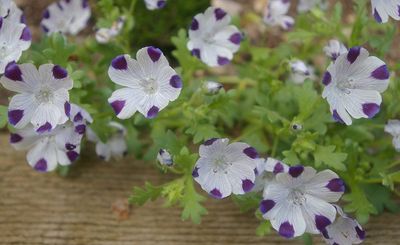About Five Spot in Containers
Rarely getting more than 8 inches (20.5 cm.) tall, five spot is ideal around the edges of containers. Its genus name, Nemophila, means ‘shade lover,’ making these pretty flowers perfect in low light situations. They also do well in areas with bright but indirect sunlight. Combining other native plants with potted baby blue eyes eases care and encourages local flora. Potted baby blue eyes have dainty 1-inch (2.5 cm.) flowers and delicate foliage. The plants are endemic to California and grow best in temperatures of 60 to 70 degrees Fahrenheit (15 to 21 C.). In hot regions, they should be grown in partial shade. The low growing plant works perfectly as a ground cover or border plant. It will even dangle delightfully in hanging baskets. These plants perform best in moist soil with plenty of compost added. Sow five spot in a pot directly or start indoors 6 weeks before the last expected frost.
How to Grow Baby Blue Eyes in a Container
Select a pot with several drainage holes. It doesn’t have to be particularly deep, as five spot has shallow root growth. Use a good potting soil with plenty of organic matter or make your own with a half and half mixture of garden soil and compost. When five spot in containers is directly sown, seeds may take 7 to 21 days to germinate. Keep the soil moist but not soggy. If combining the plants with others, use the indoor start method so plants have enough roots to compete with other species. Choose plants that also like the same lighting and have similar water needs to simplify care of container grown five spot.
Care of Five Spot in a Pot
Baby blue eyes in a container are remarkably self-sufficient. Provide them enough water to keep the top few inches (7.5 cm.) moist. The flowers are attractive to native bees which are their only pollinator. Avoid using pesticides near the plants to prevent harm to these valuable insects. If pest issues arise, spray plants with horticultural soap or use light blasts of water to wash off soft bodied insects. Deadhead to promote flowering. For even more flowers, fertilize every 6 to 8 weeks. Allow plants to die back in fall and let some flowers go to seed for a return performance the next warm season.
